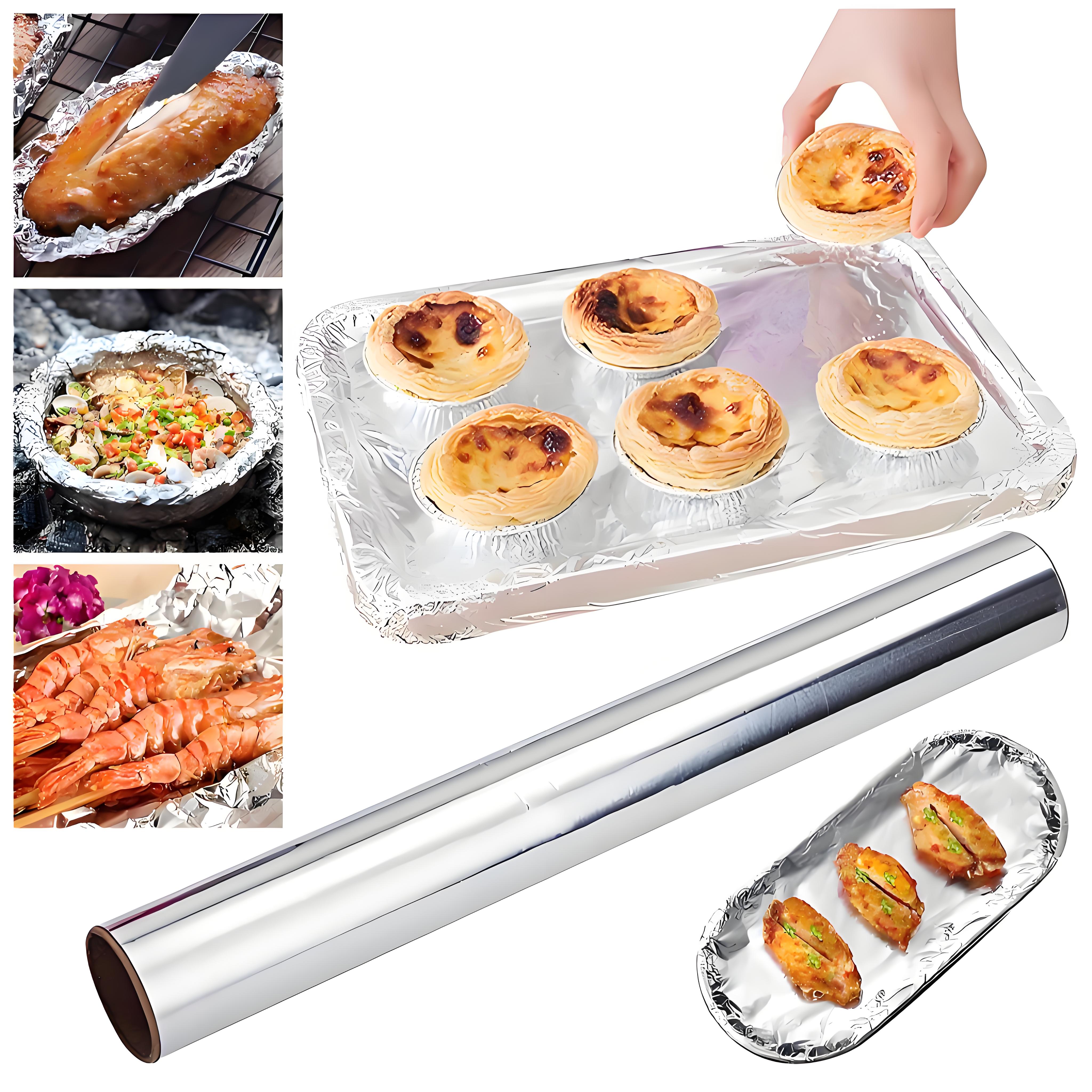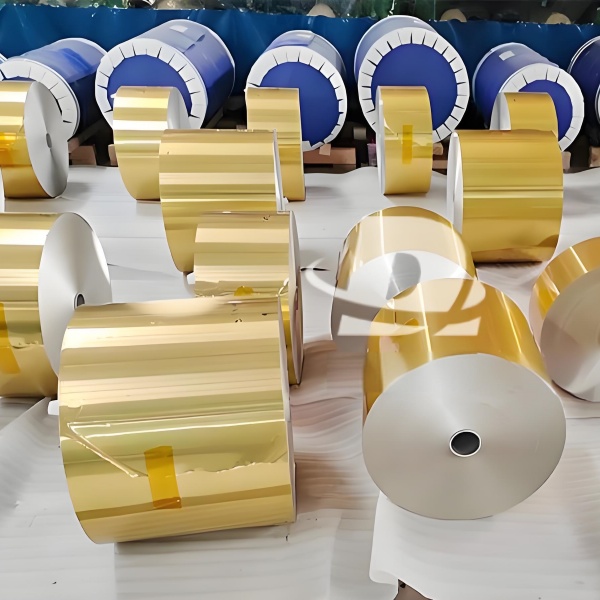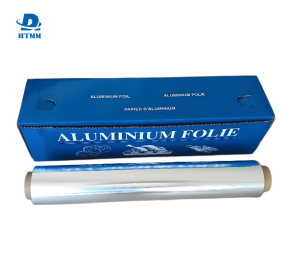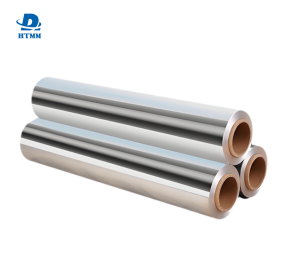Many people in the purchase of aluminum foil will find that the price of a seemingly similar roll of aluminum foil, but there is a difference, which is the most critical factor is the thickness. The “mic” here refers to microns, which is the common unit of aluminum foil thickness. 1mic equals 0.001 mm, and the larger the value, the thicker the foil.
In terms of cost, the price of aluminum foil is positively correlated with its thickness. The raw material for the production of aluminum foil is high-purity aluminum ingots, and an increase of 3mic in thickness means an increase in the amount of aluminum used per unit area of about 20%-25%. In the case of HTMM's foils, for example, the aluminum content per square meter of a 12mic foil is about 0.033 kilograms, while that of an 18mic foil is 0.049 kilograms, making the difference in raw material costs obvious.

For HTMM's three products: 12mic aluminum foil is thinner, more suitable for lightweight scenarios and relatively affordable, suitable for simple daily wrapping and freezing of ingredients; 15mic aluminum foil combines thickness and flexibility, with an intermediate price to meet the basic cooking needs of most families; 18mic aluminum foil is more expensive due to the use of more materials but more durable and adaptable, suitable for the strongest scenarios. The 18mic aluminum foil is slightly more expensive, but more durable and adaptable, suitable for scenes that require strength. This price gradient is essentially the embodiment of “a point of thickness, a point of cost”, so that consumers with different needs can choose according to their needs and avoid paying extra for unnecessary thickness.
In the aluminum foil market, “Standard” and “Heavy Duty” are common classifications, and HTMM's 12mic, 15mic, and 18mic foils correspond to the typical specifications of these two categories. The core difference lies in the “capacity boundary”.
Generally speaking, 12mic-15mic foils fall into the category of standard aluminum foils, as is the case with these two HTMM products. They are characterized by their “lightness and toughness”: moderate thickness, good ductility, unfolding with a simple tear, and a tight fit when wrapping irregular ingredients (e.g., ribs, vegetables) without cracking due to hardness. Everyday use it to wrap leftovers and put them in the refrigerator to isolate odors; cover a microwave-heated bowl to prevent soup from splashing; and even pad it in a lunch box to portion out salads, which is also easy to do.
The “capability boundary” of standard aluminum foil is more inclined to room temperature or medium-low temperature scenarios. It is perfectly fine to be exposed to temperatures around 100℃ for a short period of time (e.g. boiling water steaming), but when it is in a high-temperature environment for a long period of time (e.g. above 200℃ in the oven), it may be partially broken due to lack of strength. Therefore, it is more suitable as a “daily auxiliary tool” to handle high-frequency and light kitchen needs.

18mic aluminum foil is a typical heavy-duty aluminum foil that HTMM has created for high-temperature cooking scenarios. Compared to standard aluminum foil, it is “hardcore” in three ways: first, it is more tear-resistant, so it is not easy to get holes even when wrapping bony ingredients or folding them over and over again; second, it is more heat-resistant, so it can withstand high oven temperatures of 220℃-250℃, and won't melt or release hazardous substances even after a long time of use; and third, it is better at bearing weight, so it won't deform due to weight when wrapping large pieces of meat or serving soups. Thirdly, it is better in weight-bearing, and it is not easy to be deformed due to weight when wrapping large pieces of meat or holding soup.
Choosing aluminum foil is not the thicker the better, nor the cheaper the better value, the key is “suitable for you”. Combined with HTMM's 12mic, 15mic and 18mic aluminum foils, these three selection tips may help you find a cost-effective choice.
Step 1: Set the thickness according to the scenario, and refuse “functional waste”
The scenario with the highest frequency of daily use often determines the optimal thickness of aluminum foil. If your home is mainly used for “refrigeration, wrapping and short-term heating”, 12mic aluminum foil is enough to cope with it: use it to wrap slices of toast to take away in the morning, and cover leftovers and put them in the refrigerator at noon, which is lightweight and saves money. For the occasional oven-baked chicken wing or steamed fish, 15mic aluminum foil is more suitable - it's a little thicker than 12mic, slightly more heat-resistant, and can remain stable at temperatures around 180°C. But if you're a baking enthusiast, you'll want to use this foil more often.
However, if you are a baking enthusiast and often bake cakes or whole chickens, or need to cook at high temperatures for a long time, 18mic heavy duty aluminum foil is the “need of the hour”. It fits securely around the edges of the baking pan to prevent grease from seeping through, and can even be used to directly wrap ingredients and place them on the charcoal grill without worrying about breakage due to high temperatures.
Step 2: Stare at the details to see the quality, safety is the bottom line
The core of food-grade aluminum foil is “safety”, which cannot be compromised. When selecting, you can pay attention to three details: first, look at the logo, recognize the words “for food contact”, HTMM's aluminum foil packaging will be clearly marked on the implementation of the standard (such as GB 4806.10-2016), to ensure that it meets the requirements of the national food safety; second is to touch the texture, high-quality aluminum foil with smooth surface and no impurities, good ductility, like the HTMM's 12mic aluminum foil is thin, but it is not easy to break by stretching, while low-quality aluminum foil is easy to appear wrinkles, spots, and even cracked once torn; third, smell, good aluminum foil has no odor, if you open the package with a pungent taste, it may be the addition of unqualified additives, so you need to be careful to buy.
Step 3: Trust the brand and look at the process, stability is the long-term cost-effective
The stability of the quality of aluminum foil is often hidden in the brand's process strength. HTMM aluminum foil factory has more than 10 years of rolling experience, from the melting of the ingot to the cutting of the finished product, the whole process adopts the automated production line, and it can accurately control the thickness error within ±0.5mic - which means that the thickness of each roll is uniform and there will be no “this side is thin and that side is thick”. This means that the thickness of each roll of aluminum foil is uniform, and there is no “this side is thin, that side is thick”.
The benefits of this stability are very practical: for example, when baking with 15mic aluminum foil, the ingredients will not stick to the baking sheet due to localized thinness; when wrapping the ingredients with 18mic aluminum foil, the weight bearing is even in all places, so it is not easy to have localized breakage. On the contrary, poor quality aluminum foil is often uneven in thickness, resulting in “breakage where it should be heat-resistant and too thick where it should be lightweight”, which increases the cost of use.

The value of kitchen utensils is always hidden in the “just right”, HTMM's 12mic, 15mic and 18mic food-grade aluminum foil rolls are like customized solutions for different cooking scenarios. HTMM's 12mic, 15mic and 18mic food-grade aluminum foil rolls are like customized “solutions” for different cooking scenarios -- from daily use to high-temperature baking, from economical to hardcore durability, there is always a suitable one for you.
If you are looking for the best value for money, the 12mic aluminum foil can meet most of your daily needs; if you want to take care of multiple scenarios, the 15mic is a safe choice; and for baking enthusiasts or high-frequency and high-temperature cooking families, the 18mic heavy-duty aluminum foil will make cooking more worry-free. After all, a good roll of aluminum foil not only reduces the hassle of cleaning the kitchen, but also helps to take good care of the deliciousness of the ingredients - this is probably what the HTMM aluminum foil factory has insisted on for many years: to make every cooking more comfortable with professional quality.





